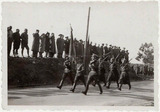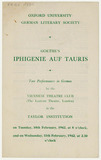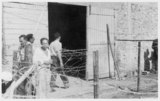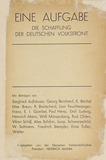The Rieucros internment camp
From October 1939 onwards and several months before the internment of “enemy foreigners” in France was expanded to include women, the French authorities began to intern foreign women whose politics apparently made them especially suspect at the Rieucros camp near the small town of Mende. Some emigrants who had come to France to escape National Socialist persecution were also brought to the camp.
The Salon of Alma Mahler-Werfel
Meeting place for emigrants in HollywoodIn the autumn of 1940, Alma Mahler-Werfel managed to flee with her husband Franz Werfel from the south of France to the USA. In January 1941, the Werfels moved to Los Angeles, which had been recommended by the writer Friedrich Torberg.
The Spanish Civil War and exile
Hope in the struggle against HitlerThe outbreak of the Spanish Civil War was triggered by a military coup led by General Franco against the government of the Spanish Republic on July 18, 1936. The subsequent suppression of the popular uprising by the Spanish population in many parts of the country triggered a wave of solidarity, especially among German emigrants.
The term “degenerate” in the art world
How a destructive idea developedTheories on the concepts of “degeneration” developed in the humanities and natural sciences in the 19th century and were eventually transferred to the arts. It was assumed that all art is organic in origin and therefore can be classified as “sound” or “abnormal”.
Theater
When an actor is unable to work in his native language, he lacks a fundamental means of expression. That is why, among theatre people, the exile situation interferes directly with their work. And yet despite this, some actors managed to find work and in many countries created their own cultural life in the German language.
USA
Several immigrants had submitted forms for asylum in the US as early as 1933. However early on, many believed that their exile would be of short duration.
Vichy Regime
As a result of the successful German Western Offensive in 1940, France became a divided country. The Netherlands, Belgium and France were defeated by Germany in an offensive attack carried out from May to 25 June, 1940.
Villa Romana
Although Italy in the years leading up to the Second World War was ruled by a fascist dictator, the government's policy concerning the arts was less repressive than under German fascism. As a result, many Germans working in the arts emigrated to places such as Florence.
Visual arts
Artists who expressed their sympathy for communist groups and ideals in the Weimar Republic were already subjected to Nazi persecution at an early stage and this led to the first waves of emigration from Germany. Others who had still held out in Germany, but who already had to deal with repression and professional bans (Berufsverbot) because they belonged to the avante-garde movement, realised in 1937 (at the latest) the danger they faced if they stayed in Germany, when the Nazis organized their propaganda exhibition against what they referred to as “Degenerate Art” (”Entartete Kunst”).
Volksfront (People's Front)
From 1932 until the beginning of the Second World War, the "Volksfront" was a coalition which united the opponents of the Nazis. In the 1932 Reich presidential campaign it included parties from the monarchists to the SPD and, in the referendum in the Saar region in January 1935, the Social Democratic Party of Saarland, the Communist Party, small left wing parties and factions of the German Centre Party.











